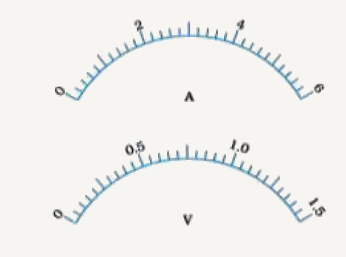Four students connect 4 cells of 1.5 V each to get a battery of voltage 6 V. State the incorrect connection / connections. Justify your answer.
 Solution in Gujrati
Solution in Gujrati
A, B and C are incorrect connections (D is correct).
Because for a proper series connection of four cells, each of 1.5 V to obtain a battery of 6 V, the negative terminal of each cell should be connected to the positive terminal of the nextcell or the positive terminal of each cell shouldbe connected to the negative terminal of the next cell (connection D).
Topper's Solved these Questions
- BOOK - KUMAR PRAKASHANCHAPTER - ELECTRICITYEXERCISE - VALUE BASED QUESTIN WITH ANSWERS15videos
ELECTRICITY
- BOOK - KUMAR PRAKASHANCHAPTER - ELECTRICITYEXERCISE - PRACTICAL SKILL BASED QUESTION WITH ANSWERS20videos
ELECTRICITY
- BOOK - KUMAR PRAKASHANCHAPTER - ELECTRICITYEXERCISE - OBJECTIVE QUESTIONS AND ANSWERS (Choose the correct option from those given below each question: )55videos
ELECTRICITY
- BOOK - KUMAR PRAKASHANCHAPTER - MAGNETIC EFFECTS OF ELECTRIC CURRENT EXERCISE - VALUE BASED QUESTIONS WITH ANSWERS15videos
MAGNETIC EFFECTS OF ELECTRIC CURRENT
Similar Questions
Medha observed that the tubelights in the corridor of her school were always switched on the whole day. She brought the matter to the notice of her class teacher who talked to the Principal about it. The Principal took immediate action.
Medha helped this way to reduce air pollution. Explain how.04:03View SolutionThe scales of an ammeter and a voltmeter are shown below:

What is the range of the ammeter and the range of the voltmeter?View SolutionThe SI unit of electric charge is the ……………… .
02:03View SolutionShalini and his brother Amey observed a water-pump working , Shalini inquired how an electric motor works . Amey collected different parts of an electric motor e.g., field - magnets , cabon- brushes , armature , battery , switch, connecting wire , split - rings , etc, and showed them to Shalini . Amey then explained how an armature could rotate.
State the principle how an electric motor to works .01:23View SolutionThree identical cells each of 2 V and unknow internal resistance are connected in parallel. This combination is connected to a 5 ohm resistor. IF the terminal voltage across the cell is 1.5 volt, what is the internal resistance of each cell?
02:56View SolutionThree identical cells each of emf 2 V and unknown internal resistance are connected in parallel. This combination is connected to a 5 Omega resistor. If the terminal voltage across the cells is 1.5 V, what is the internal resistance of each cell ?
02:37View SolutionA student has to connect 4 cells of 2 V each to form a battery of voltage 8 V. The correct way of connecting these cells is shown in figure :
03:38View SolutionFour cells, each of e.m.f 1.5 V, are connected in series to form a battery. Find the e.m.f of the bettery.
03:10View SolutionFour cells of e.m.f. 2.5 V each are connected in series to form a battery, the e.m.f. of the battery is _______.
03:09View SolutionObserve the circuit and state whether the cells are connected in series or parallel. If each cell is of e.m.f. 1.5 V , then find the total e.m.f applied across the bulb connected.
02:27View Solutionएक विद्यार्थी को 1.5 V वोल्टता के चार अलग-अलग सेलों को जोड़कर 6 वोल्टता की एक बैटरी बनानी है। इसके लिए सेलों का सही संयोजन दर्शाया गया है चित्र
 View Solution
View SolutionA battery is designed by connecting four cells, each of emf 1.5 V and resistance 2.0 ohm in parallel. If this battery is now connected to an resistance of 2.5 ohm, find the total resistance of the circuit
View SolutionA battery is designed by connecting four cells, each of emf 1.5 V and resistance 2.0 ohm in parallel. If this battery is now connected to an resistance of 2.5 ohm, find
the current flowing in the external circuit01:23View SolutionA battery is designed by connecting four cells, each of emf 1.5 V and resistance 2.0 ohm in parallel. If this battery is now connected to an resistance of 2.5 ohm, find the potential drop across the terminal of the cells.
02:37View SolutionConnect 1.5 V, 3 V and 6 V batteries in the circuit and find out the voltage available to the bulb in each case and record it in the table.
'(##VPU_TTT_IX_PHY_C06_E01_002_Q01##)'02:43View Solution

